OLDSMOBILE SILHOUETTE 1997 Owners Manual
Manufacturer: OLDSMOBILE, Model Year: 1997, Model line: SILHOUETTE, Model: OLDSMOBILE SILHOUETTE 1997Pages: 436, PDF Size: 21.87 MB
Page 221 of 436
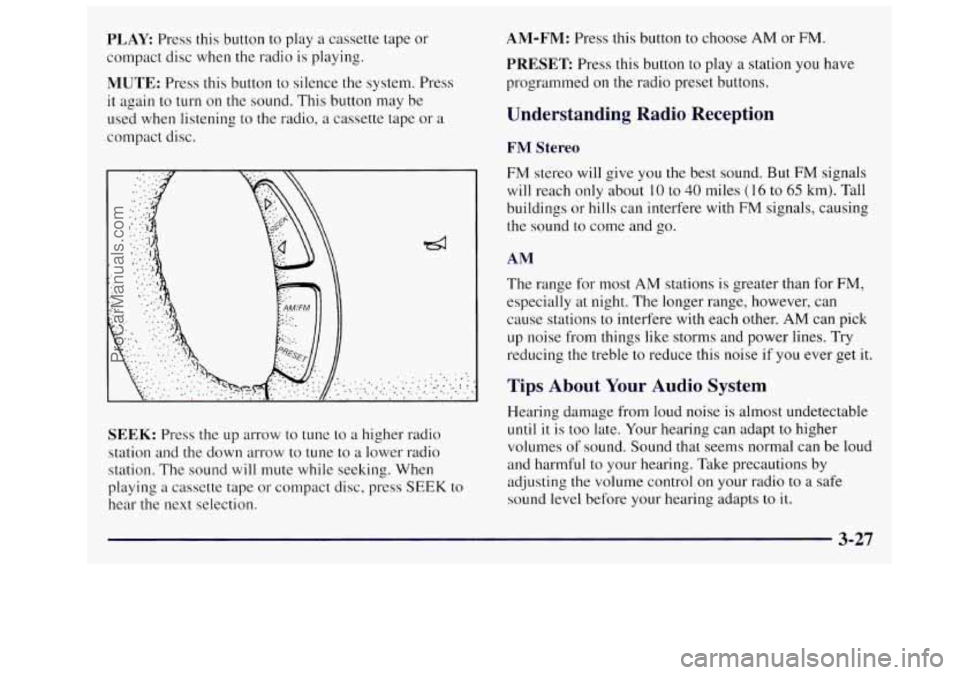
PLAY Press this button to play a cassette tape or
compact disc when the radio is playing.
MUTE: Press this button to silence the system. Press
it again to turn on the sound. This button may be
used when listening to the radio, a cassette tape or
a
compact disc.
SEEK: Press the up arrow to tune to a higher radio
station and the down arrow to tune to
a lower radio
station. The sound
will mute while seeking. When
playing a cassette tape or compact disc, press
SEEK to
hear the next selection.
AM-FM: Press this button to choose AM or FM.
PRESET Press this button to play a station you have
programmed on the radio preset buttons.
Understanding Radio Reception
FM Stereo
FM stereo will give you the best sound. But FM signals
will reach only about
10 to 40 miles (16 to 65 km). Tall
buildings or hills can interfere with
FM signals, causing
the sound to come and go.
AM
The range for most AM stations is greater than for FM,
especially at night. The longer range, however, can
cause stations to interfere with each other.
AM can pick
up noise from things like storms and power lines. Try
reducing the treble
to reduce this noise if you ever get it.
Tips About Your Audio System
Hearing damage from loud noise is almost undetectable
until it is too late. Your hearing can adapt to higher
volumes
of sound. Sound that seems normal can be loud
and harmful to your hearing. Take precautions by
adjusting
the volume control on your radio to a safe
sound level before your hearing adapts to
it.
3-27
ProCarManuals.com
Page 222 of 436
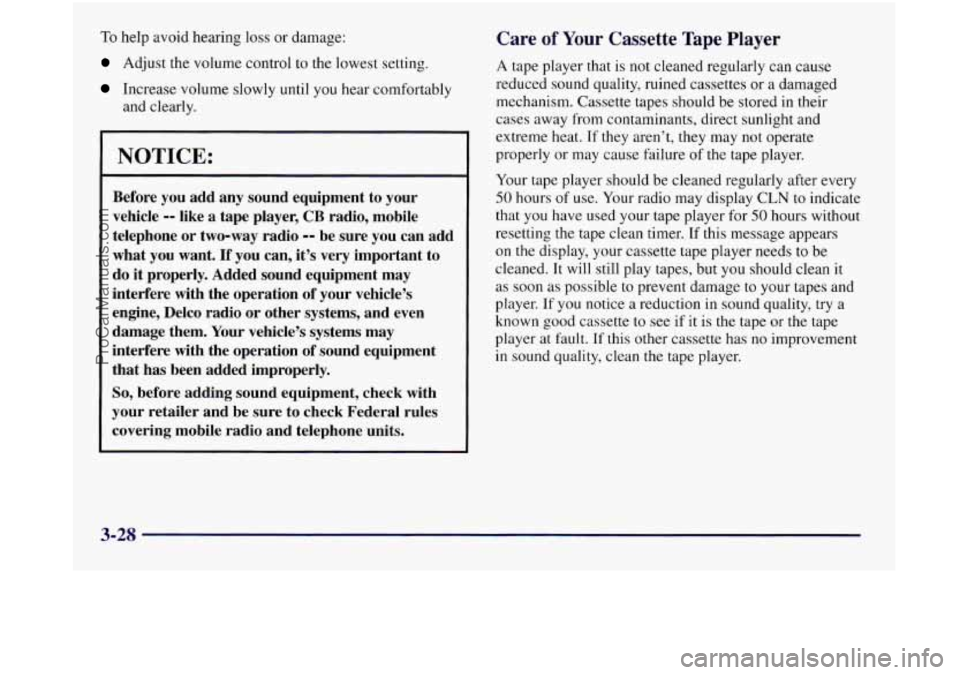
To help avoid hearing loss or damage:
Adjust the volume control to the lowest setting.
Increase volume slowly until you hear comfortably
and clearly.
NOTICE:
r
Before you add any sound equipment to your
vehicle
-- like a tape player, CB radio, mobile
telephone or two-way radio
-- be sure you can add
what you want.
If you can, it’s very important to
do it properly. Added sound equipment may
interfere with the operation of your vehicle’s
engine, Delco radio or other systems, and even
damage them. Your vehicle’s systems may
interfere with the operation of sound equipment
that has been added improperly.
So, before adding sound equipment, check with
your retailer and be sure to check Federal rules
covering mobile radio and telephone units.
Care of Your Cassette Tape Player
A tape player that is not cleaned regularly can cause
reduced sound quality, ruined cassettes or a damaged
mechanism. Cassette tapes should be stored in their
cases away from contaminants, direct sunlight and
extreme heat. If they aren’t, they may not operate
properly or may cause failure of the tape player.
Your tape player should be cleaned regularly after every
50 hours of use. Your radio may display CLN to indicate
that you have used your tape player for
50 hours without
resetting the tape clean timer. If this message appears
on the display, your cassette tape player needs to be
cleaned.
It will still play tapes, but you should clean it
as soon as possible to prevent damage to your tapes and
player. If you notice a reduction in sound quality, try a
known good cassette
to see if it is the tape or the tape
player at fault. If this other cassette has no improvement
in sound quality, clean the tape player.
3-28
ProCarManuals.com
Page 223 of 436
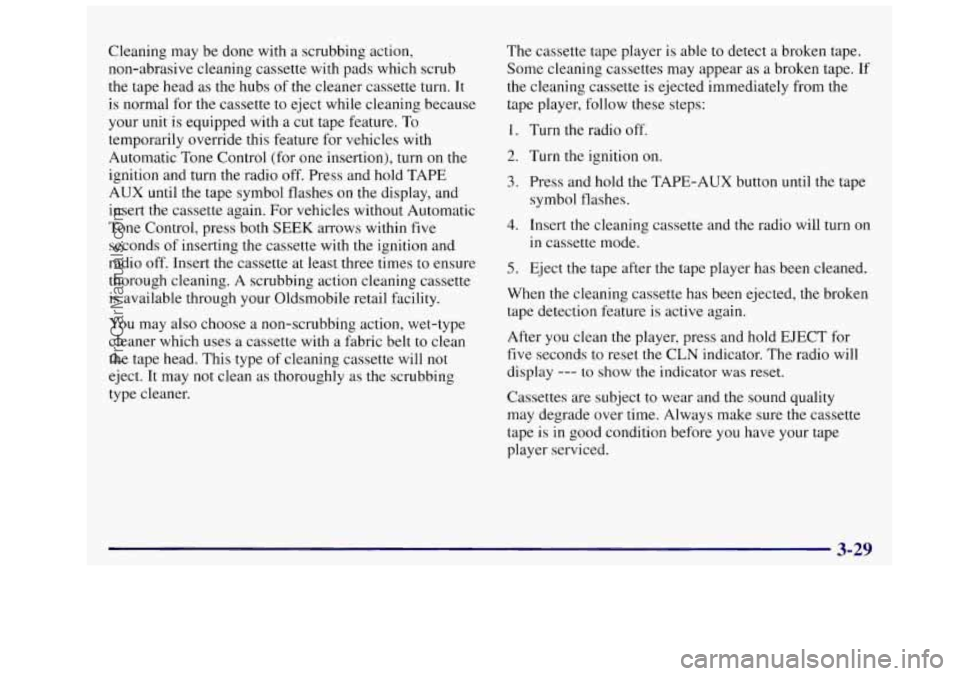
Cleaning may be done with a scrubbing action,
non-abrasive cleaning cassette with pads which scrub
the tape head as the hubs of the cleaner cassette turn. It
is normal for
the cassette to eject while cleaning because
your unit is equipped with a cut tape feature. To
temporarily override this feature for vehicles with
Automatic Tone Control (for one insertion), turn on the
ignition and turn the radio off. Press and hold TAPE
AUX until the tape symbol flashes
on the display, and
insert the cassette again. For vehicles without Automatic
Tone Control, press both
SEEK arrows within five
seconds of inserting the cassette with the ignition and
radio off. Insert the cassette at least three times to ensure
thorough cleaning.
A scrubbing action cleaning cassette
is available through your Oldsmobile retail facility.
You may also choose a non-scrubbing action, wet-type
cleaner which uses a cassette with a fabric belt to clean
the tape head. This type
of cleaning cassette will not
eject. It may not clean as thoroughly as the scrubbing
type cleaner. The cassette
tape player
is able to detect a broken tape.
Some cleaning cassettes may appear as a broken tape. If
the cleaning cassette is ejected immediately from the
tape player, follow these steps:
1. Turn the radio off.
2. Turn the ignition on.
3. Press and hold the TAPE-AUX button until the tape
symbol flashes.
4. Insert the cleaning cassette and the radio will turn on
in cassette mode.
5. Eject the tape after the tape player has been cleaned.
When
the cleaning cassette has been ejected, the broken
tape detection feature is active again.
After you clean the player, press and hold EJECT for
five seconds to reset the CLN indicator. The radio will
display
--- to show the indicator was reset.
Cassettes are subject to wear and the sound quality
may degrade over time. Always make sure the cassette
tape is
in good condition before you have your tape
player serviced.
3-29
ProCarManuals.com
Page 224 of 436
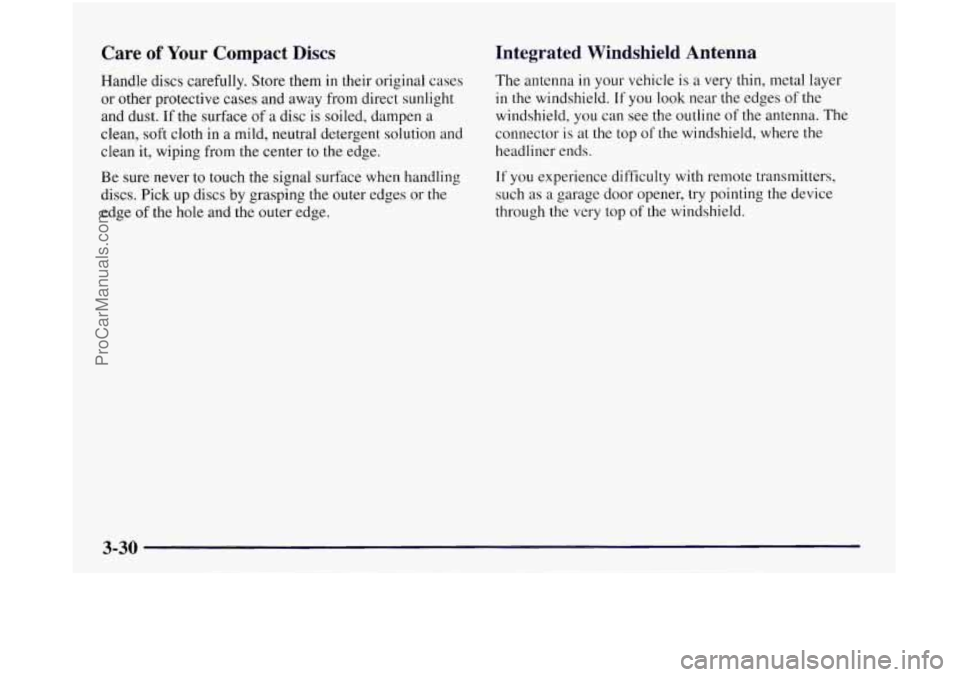
Care of Your Compact Discs
Handle discs carefully. Store them in their original cases
or other protective cases and away from direct sunlight
and dust. If the surface
of a disc is soiled, dampen a
clean, soft cloth in a mild, neutral detergent solution and
clean it, wiping from the center to the edge.
Be sure never to touch the signal surface
when handling
discs. Pick
up discs by grasping the outer edges or the
edge of the hole and the outer edge.
Integrated Windshield Antenna
The antenna in your vehicle is a very thin, metal layer
in the windshield.
If you look near the edges of the
windshield, you can see the outline of the antenna. The
connector
is at the top of the windshield, where the
headliner ends.
If you experience difficulty with remote transmitters,
such
as a garage door opener, try pointing the device
through the very top of the windshield.
3-30
ProCarManuals.com
Page 225 of 436
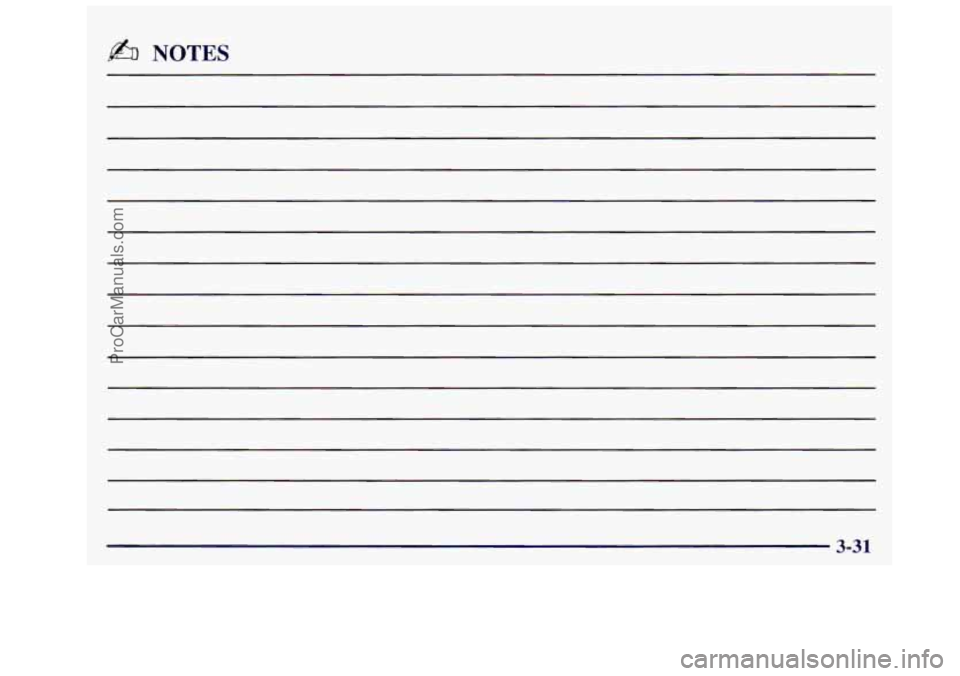
& NOTES
3-31
ProCarManuals.com
Page 226 of 436
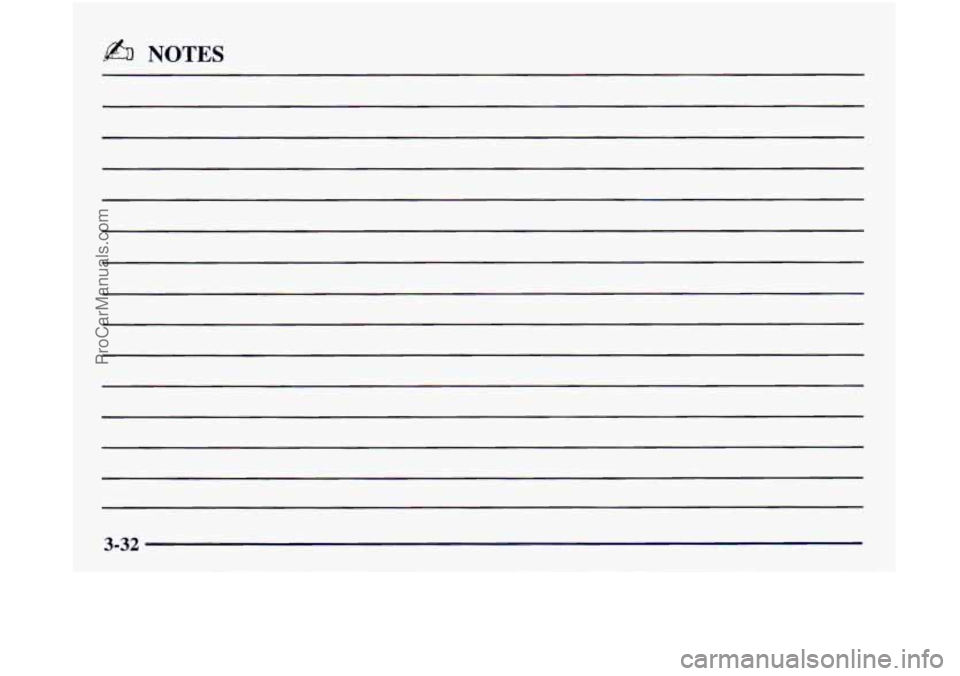
fi NOTES
3-32
ProCarManuals.com
Page 227 of 436
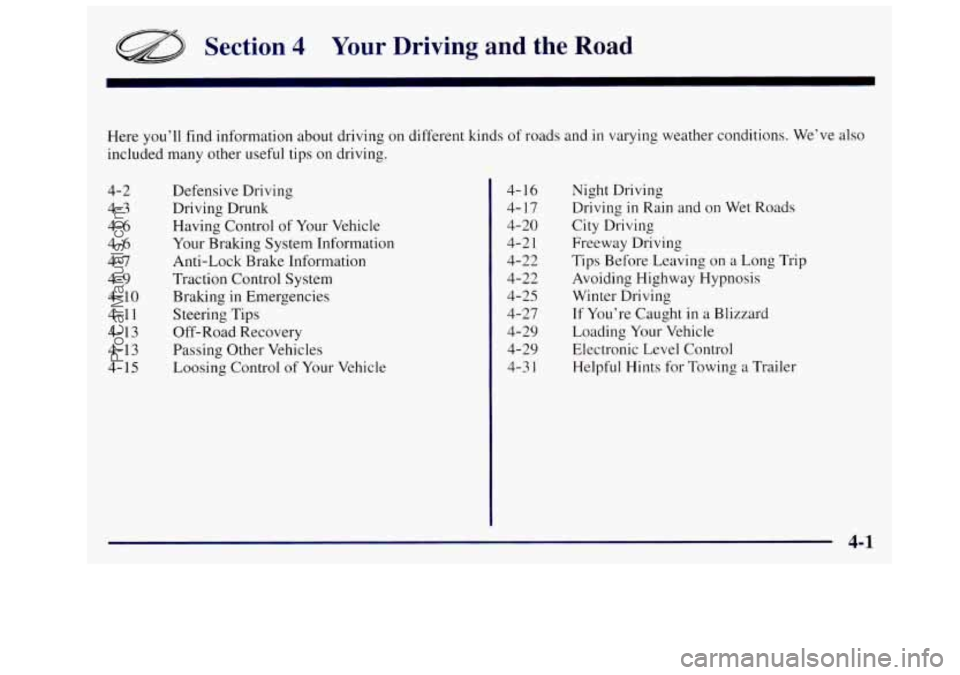
Section 4 Your Driving and the Road
Here you’ll find information about driving on different kinds of roads and in varying weather conditions. We’ve also
included many other useful tips on driving.
4-2
4-3
4-6
4-6
4-7
4-9 4- 10
4-1 1
4-13
4- 13
4- 15 Defensive Driving
Driving
Drunk
Having Control of Your Vehicle
Your Braking System Information
Anti-Lock Brake Information
Traction Control System
Braking in Emergencies
Steering Tips
Off-Road Recovery
Passing Other Vehicles
Loosing Control
of Your Vehicle 4-
16
4-
17
4-20
4-2
1
4-22
4-22
4-25
4-27
4-29 4-29
4-3
1
Night Driving
Driving
in Rain and on Wet Roads
City Driving
Freeway Driving
Tips Before Leaving on
a Long Trip
Avoiding Highway Hypnosis
Winter Driving
If You’re Caught in
a Blizzard
Loading Your Vehicle
Electronic Level Control
Helpful Hints for Towing
a Trailer
ProCarManuals.com
Page 228 of 436
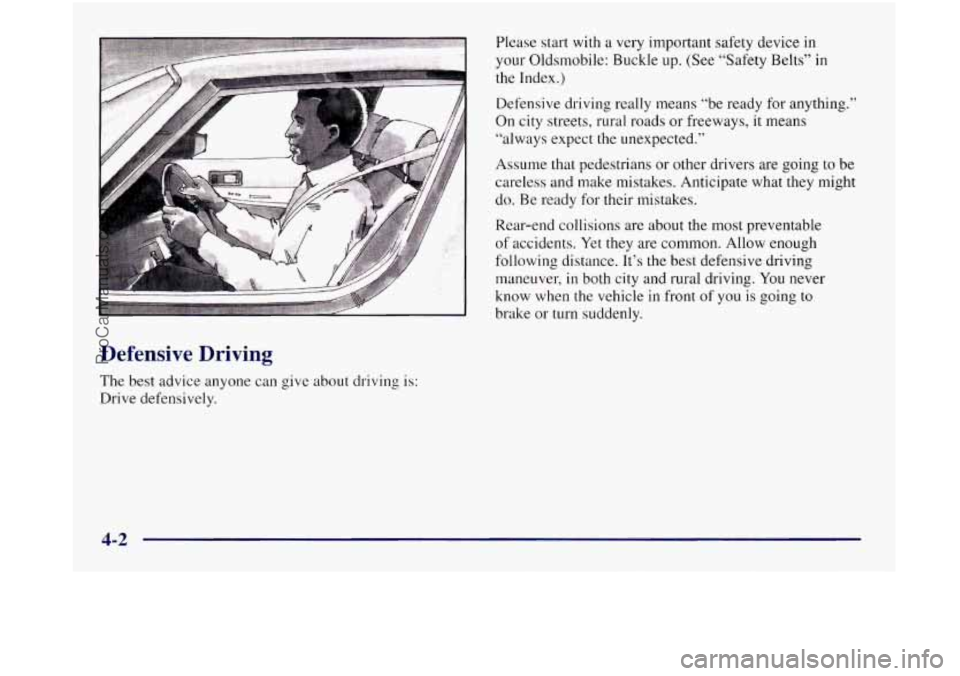
Please start with a very important safety device in
your Oldsmobile: Buckle
up. (See “Safety Belts” in
the Index.)
Defensive driving really means “be ready for anything.”
On city streets, rural roads
or freeways, it means
“always expect
the unexpected.”
Assume that pedestrians or other drivers are going to be
careless and make mistakes. Anticipate what they might
do. Be ready for their mistakes.
Rear-end collisions are about the most preventable
of accidents.
Yet they are common. Allow enough
following distance. It’s
the best defensive driving
maneuver,
in both city and rural driving. You never
know when the vehicle in front of you
is going to
brake or turn suddenly.
Defensive Driving
The best advice anyone can give about driving is:
Drive defensively.
4-2
ProCarManuals.com
Page 229 of 436
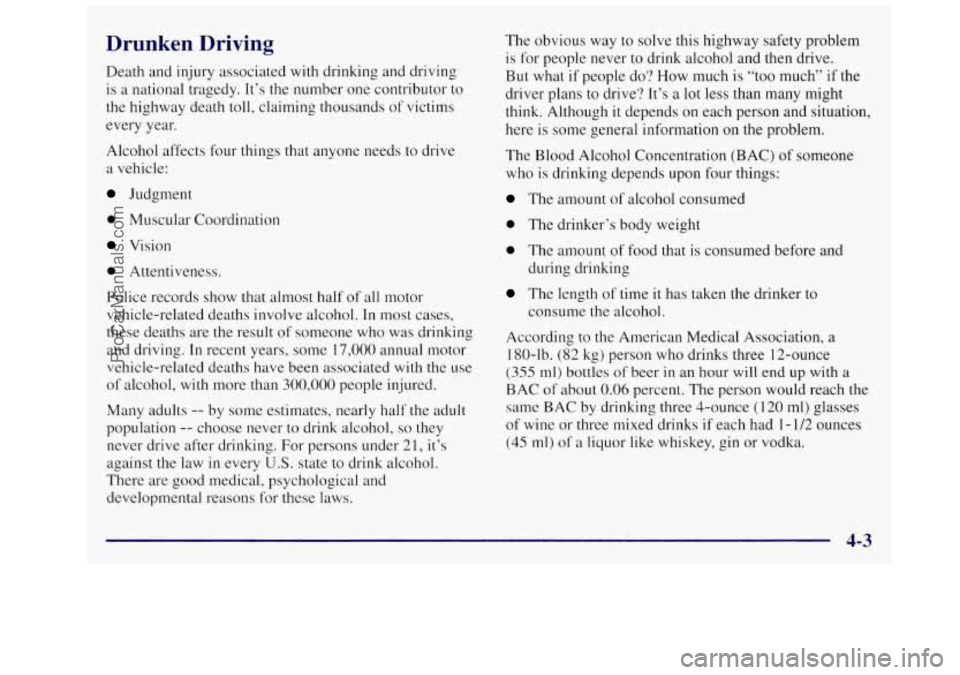
Drunken Driving
Death and injury associated with drinking and driving
is
a national tragedy. It’s the number one contributor to
the highway death toll, claiming thousands of victims
every year.
Alcohol affects four things that anyone needs to drive
a vehicle:
Judgment
0 Muscular Coordination
Vision
0 Attentiveness.
Police records show that almost half
of all motor
vehicle-related deaths involve alcohol.
In most cases,
these deaths are the result
of someone who was drinking
and driving.
In recent years, some 17,000 annual motor
vehicle-related deaths have been associated with the use
of alcohol, with more than
300,000 people injured.
Many adults
-- by some estimates, nearly half the adult
population
-- choose never to drink alcohol, so they
never drive after drinking. For persons under
2 1, it’s
against the law in every
U.S. state to drink alcohol.
There are good medical, psychological and
developmental reasons for these laws. The obvious
way to solve this highway safety problem
is for people never to drink alcohol and then drive.
But what
if people do? How much is “too much” if the
driver plans to drive? It’s a lot less than many might
think. Although
it depends on each person and situation,
here is some general information on the problem.
The Blood Alcohol Concentration (BAC)
of someone
who is drinking depends upon four things:
The amount of alcohol consumed
0 The drinker’s body weight
0 The amount of food that is consumed before and
during drinking
The length of time it has taken the drinker to
consume the alcohol.
According to the American Medical Association, a
180-lb. (82 kg) person who drinks three 12-ounce
(355 ml) bottles of beer in an hour will end up with a
BAC
of about 0.06 percent. The person would reach the
same BAC by drinking three 4-ounce
(I 20 ml) glasses
of wine or three mixed drinks if each had 1 - 1/2 ounces
(45 ml) of a liquor like whiskey, gin or vodka.
4-3
ProCarManuals.com
Page 230 of 436
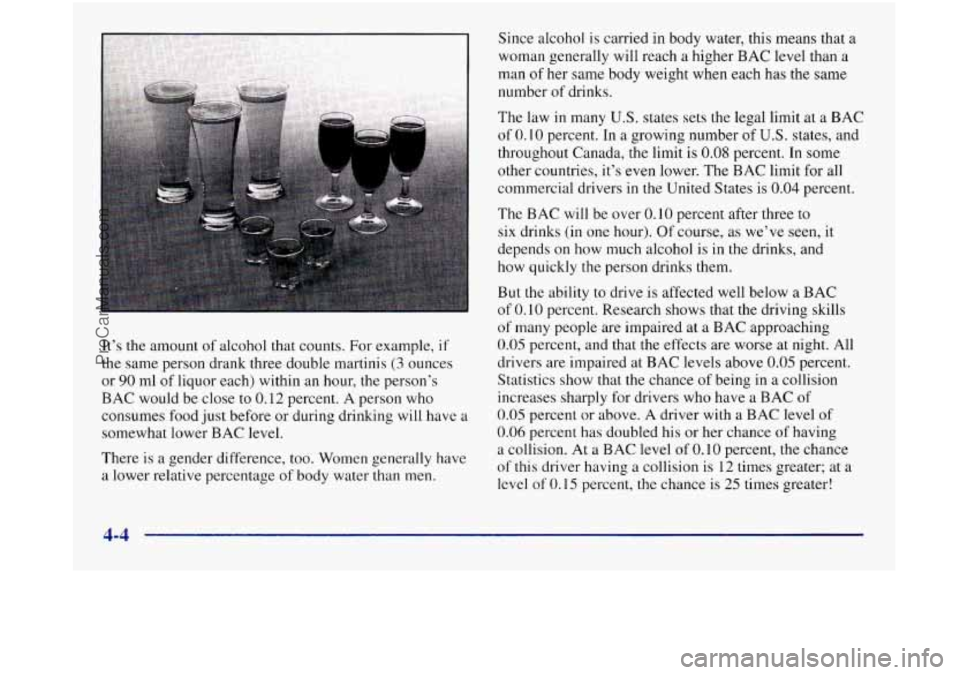
It’s the amount of alcohol that counts. For example, if
the same person drank three double martinis (3 ounces
or
90 ml of liquor each) within an hour, the person’s
BAC would be close to 0.12 percent. A person who
consumes food just before or during drinking will have a
somewhat lower BAC level.
There is a gender difference, too. Women generally have
a lower relative percentage
of body water than men. Since
alcohol
is carried in body water, this means that a
woman generally will reach
a higher BAC level than a
man
of her same body weight when each has the same
number
of drinks.
The law
in many U.S. states sets the legal limit at a BAC
of 0.10 percent. In a growing number of
U.S. states, and
throughout Canada, the limit is
0.08 percent. In some
other countries, it’s even lower.
The BAC limit for all
commercial drivers in the United States
is 0.04 percent.
The BAC will be over 0.10 percent after three to
six drinks
(in one hour). Of course, as we’ve seen, it
depends on how much alcohol
is in the drinks, and
how quickly the person drinks them.
But the ability to drive is affected well below
a BAC
of 0.10 percent. Research shows that the driving skills
of many people are impaired at a BAC approaching
0.05 percent, and that the effects are worse at night. All
drivers are impaired at BAC levels above
0.05 percent.
Statistics show that the chance
of being in a collision
increases sharply for drivers who have a BAC of
0.05 percent or above. A driver with a BAC level of
0.06 percent has doubled his or her chance of having
a collision. At a BAC level of 0.10 percent, the chance
of this driver having a collision
is 12 times greater; at a
level of 0.15 percent, the chance is 25 times greater!
4-4
ProCarManuals.com